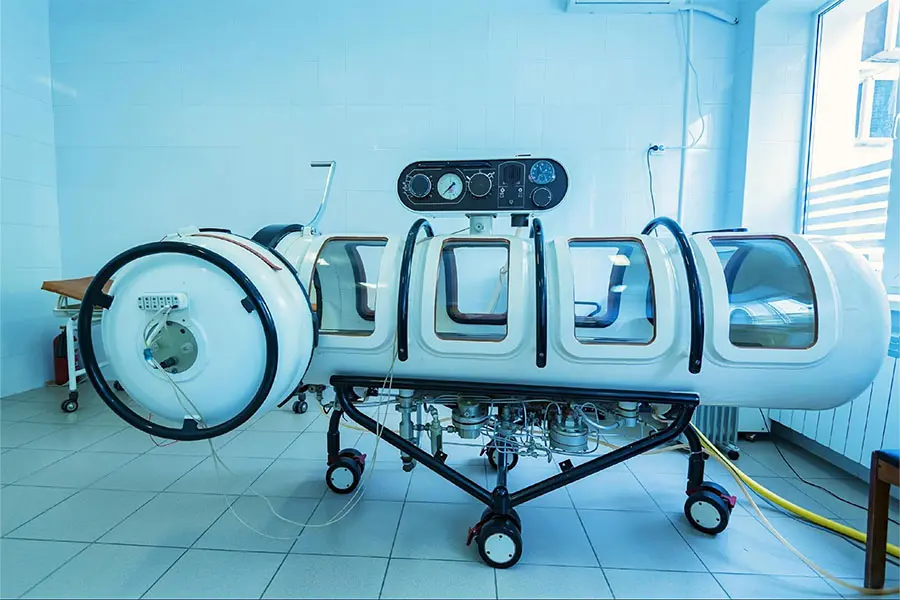Celebrities and athletes are great publicity fodder. What are they wearing? Who are they dating? Did they buy a mansion on the coast? What diet or exercise regimen are they following? That last question about their wellness choices brings up a new celebrity fad: hyperbaric chambers. Among the rich and famous who own or use such chambers are Justin Bieber, LeBron James, Michael Phelps and Madonna. Their reasons include slowing aging, healing injuries, and increasing immunity.
A hyperbaric chamber looks like something out of a science fiction novel (claustrophobes beware!) but Hyperbaric Oxygen Therapy (HBOT) is a down-to-earth clinical resource. As the prefix “hyper” suggests, it’s doing something above the ordinary—in this case, supersaturating the amount of available oxygen, a naturally occurring gas. The person lying in the chamber is infused with 100% pressurized oxygen. Not only does it seem to help the red blood cells that pick up oxygen in the lungs for distribution in the body, it also directly diffuses oxygen into tissues due to the increased pressure. This nurtures cells and fosters their processes. In the case of wound healing, HBOT boosts the regeneration of damaged cells. This raises the question, if a cancer patient is placed in a hyperbaric chamber, will the concentrated oxygen benefit the malignant cells? Theoretically, it may accelerate the growth of tumors during their proliferation stage.[i]

HBOT and cancer
Oxygen is a good thing. We all need it to live. Deprive individual cells of oxygen and they die. Cancer cells also need oxygen but ironically, when they are deprived of oxygen (a state called hypoxia), they can literally become more dangerous.[ii] They hijack the body’s mechanisms for adapting to low oxygen conditions (e.g., thin air at very high altitude). Take away their oxygen, and they manipulate biochemical resources to become more resistant to radiation, chemotherapy and immunotherapy.
Thus, while it seems counterintuitive, delivering more oxygen to cancer cells actually appears to short-circuit such manipulation. In many instances, infusing cancer cells with oxygen can make them easier to destroy. According to the National Cancer Institute:
“Hyperbaric oxygen may increase the amount of oxygen in cancer cells, which may make them easier to kill with radiation therapy and chemotherapy. It is a type of radiosensitizing agent and a type of chemosensitizing agent.” In one study of brain cancer patients, the authors found that using HBOT as an adjunct to radiation treatment was safe yet more effective than radiation alone.[iii]
Can HBOT serve a similar purpose for treating prostate cancer? Lu, et al. (2018) analyzed previously published laboratory and animal studies of HBOT and prostate cancer tumor cells. Such studies demonstrated that HBOT did not promote the growth of tumors, and in fact decreased the rate of growth while increasing sensitivity to anticancer treatments.[iv] Not only did HBOT inhibit prostate cancer’s potential increase in danger when hypoxic, but the authors believe the biochemical and molecular chemistry by which HBOT damages cancer cells’ DNA so they fail to reproduce and die off. This research team expressed optimism that HBOT will have a future role in safely treating prostate cancer while sparing patients from the side effect risks of more invasive treatments.
At this time, more research is needed to support the findings of researchers like Lu and others. As attractive as it seems, simply lying relaxed and breathing pure oxygen has yet to be demonstrated as a sole method for curing prostate cancer. Its role as an adjunct to radiation, chemotherapy or immunotherapy is promising. Time will tell whether HBOT offers an additional weapon in the battle against prostate cancer.
NOTE: This content is solely for purposes of information and does not substitute for diagnostic or medical advice. Talk to your doctor if you are experiencing pelvic pain, or have any other health concerns or questions of a personal medical nature.
References
[i] Lu QZ, Li X, Ouyang J, Li JQ, Chen G. Further application of hyperbaric oxygen in prostate cancer. Med Gas Res. 2019 Jan 9;8(4):167-171.
[ii] Dana Farber Cancer Institute. “Cancer and Oxygen: Why the Connection Between the Two Continues to Motivate Research.” STAT (no date) https://www.statnews.com/sponsor/2020/05/19/cancer-and-oxygen-why-the-connection-between-the-two-continues-to-motivate-research/
[iii] St?pie? K, Ostrowski RP, Matyja E. Hyperbaric oxygen as an adjunctive therapy in treatment of malignancies, including brain tumours. Med Oncol. 2016 Sep;33(9):101.
[iv] Lu QZ, Li X, Ouyang J, Li JQ, Chen G. Further application of hyperbaric oxygen in prostate cancer. Med Gas Res. 2019 Jan 9;8(4):167-171.


